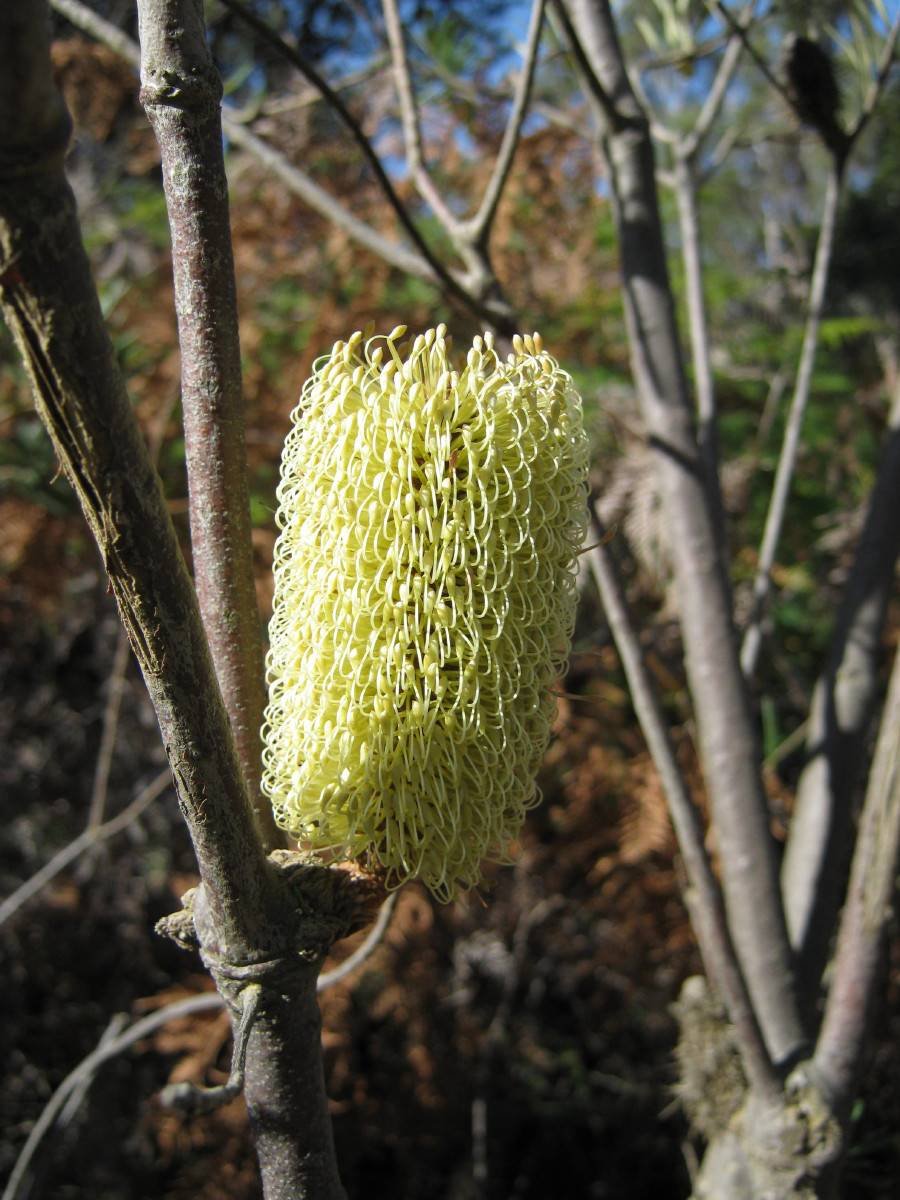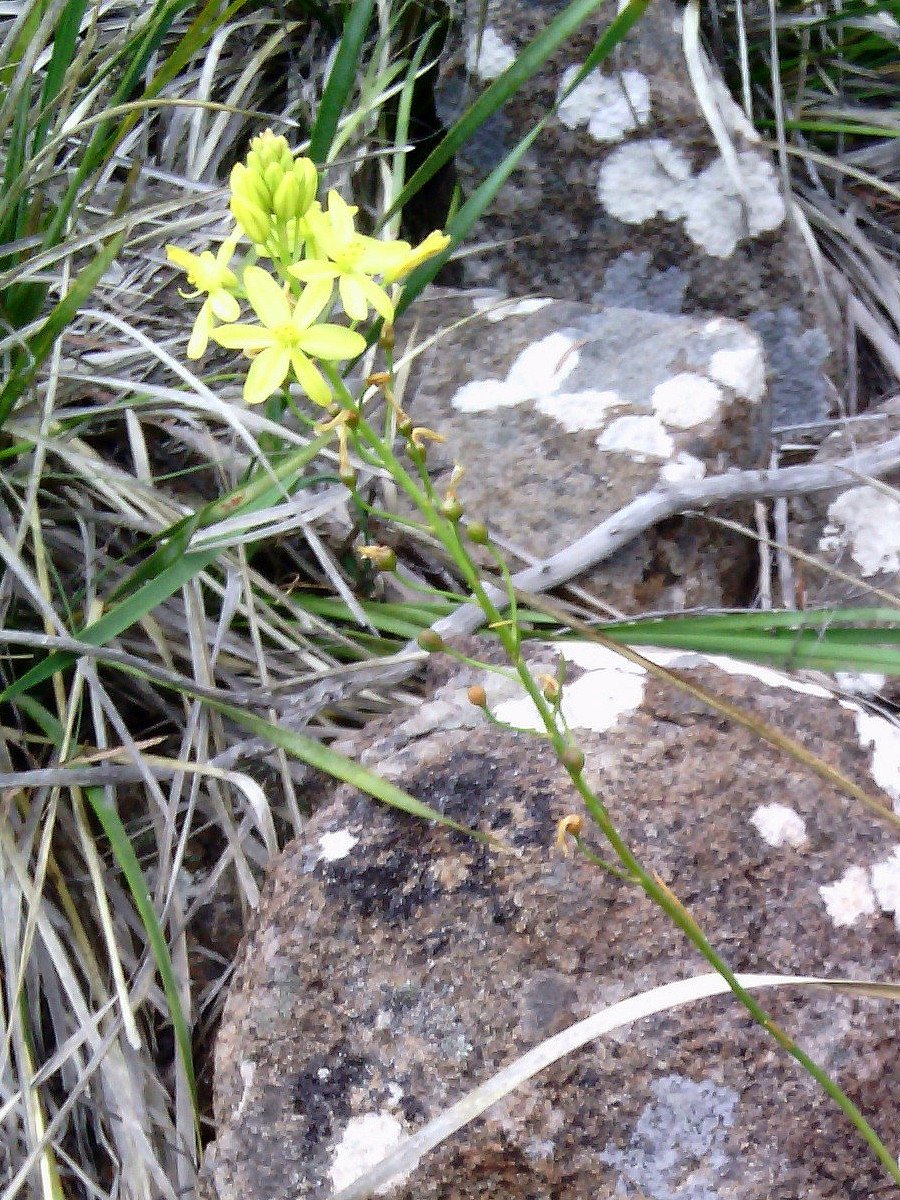 Banksia marginata, common name "Native Honeysuckle" grows as a shrub or small tree, 1 to 10m high by 0.5 to 5m wide all over Knocklofty Reserve. The beautiful, yellow, cylindrical flowers occur in summer through to autumn and attract many birds, insects and nectar loving animals. While is grows biggest in sandy soils it thrives in most well drained soils and is drought and frost hardy. It is a good coastal plant and responds rapidly to hard pruning for shape. It is also a good cut flower plant.
Banksia marginata, common name "Native Honeysuckle" grows as a shrub or small tree, 1 to 10m high by 0.5 to 5m wide all over Knocklofty Reserve. The beautiful, yellow, cylindrical flowers occur in summer through to autumn and attract many birds, insects and nectar loving animals. While is grows biggest in sandy soils it thrives in most well drained soils and is drought and frost hardy. It is a good coastal plant and responds rapidly to hard pruning for shape. It is also a good cut flower plant. Bedfordia salicina, common name "Tasmanian blanketleaf", grow as small trees from 2 to 5m high by 2 to 3m wide in the shadier and wetter areas of the Knocklofty Reserve such as along the extension of Forest road and up the Glover Track. The yellow, daisy flowers grow up the stems beneath the white backed, long, bright green, prominently veined leaves in spring. In home gardens, it requires moist, mulched, well drained soils in semi shade.
Bedfordia salicina, common name "Tasmanian blanketleaf", grow as small trees from 2 to 5m high by 2 to 3m wide in the shadier and wetter areas of the Knocklofty Reserve such as along the extension of Forest road and up the Glover Track. The yellow, daisy flowers grow up the stems beneath the white backed, long, bright green, prominently veined leaves in spring. In home gardens, it requires moist, mulched, well drained soils in semi shade. Billardiera longiflora, common name "Purple apple berry", is a gentle climber to 2 to 4m high growing on other shrubs and trees in the shadier and wetter areas of the Knocklofty Reserve. These plants have green to yellow flowers in spring through to summer followed by purple, pink, white or red (not in Knocklofty Reserve) fleshy fruit. This species prefers moist, mulched well drained soils and grows best in part to full sun.
Billardiera longiflora, common name "Purple apple berry", is a gentle climber to 2 to 4m high growing on other shrubs and trees in the shadier and wetter areas of the Knocklofty Reserve. These plants have green to yellow flowers in spring through to summer followed by purple, pink, white or red (not in Knocklofty Reserve) fleshy fruit. This species prefers moist, mulched well drained soils and grows best in part to full sun. Boronia pilosa var pilosa, common name "Hairy Boronia" (due its hairy stems) is a scented, small, erect shrub 0.3 to 1m high by 0.5 to 0.75m wide grows in the sandy heath area to the south east of the Forest Road carpark. It has pink to white star flowers in spring through to summer. It prefers well mulched and well drained, moist soils in part sun. The small bushes can be pruned for compact shape after flowers have finished or for the flowers themselves.
Boronia pilosa var pilosa, common name "Hairy Boronia" (due its hairy stems) is a scented, small, erect shrub 0.3 to 1m high by 0.5 to 0.75m wide grows in the sandy heath area to the south east of the Forest Road carpark. It has pink to white star flowers in spring through to summer. It prefers well mulched and well drained, moist soils in part sun. The small bushes can be pruned for compact shape after flowers have finished or for the flowers themselves. Brachycome aculeata, common name "Hill daisy", is a suckering herb, growing from 5 to 50cm high and spreading from 30 to 50cm in the open forest areas of Knocklofty Reserve especially along the Summit Loop Track. The plants have white, sometimes tinged with blue, spring flowers and have irregularly toothed about 5cm long lower leaves and shorter upper leaves. They are hardy in moist soils in full sun to light shade and can tolerate prolonged wet periods. The plants can tend to die back in dry weather.
Brachycome aculeata, common name "Hill daisy", is a suckering herb, growing from 5 to 50cm high and spreading from 30 to 50cm in the open forest areas of Knocklofty Reserve especially along the Summit Loop Track. The plants have white, sometimes tinged with blue, spring flowers and have irregularly toothed about 5cm long lower leaves and shorter upper leaves. They are hardy in moist soils in full sun to light shade and can tolerate prolonged wet periods. The plants can tend to die back in dry weather.
Bulbine glauca, common name Bluish bulbine-lily (due to the bluish colour of the mature leaves), is a perennial herb 15 to 60cm high by 10 to 30cm wide growing in the dolerite area especially on the summit. It has many 6 petal, yellow flowers in a spike cluster atop a stem to 50cm tall, gradually opening from the base of the spike in spring through to summer. It has globular capsules containing many seeds. This species tolerates a wide range of conditions and soils in full sun from coastal to alpine and rocky outcrops in wet sclerophyll forest. It is an easy plant to propagate and grow in most gardens and may self-seed in the right conditions, sometimes creating a swathe of tall, bright yellow flowers
 Bursaria spinosa, common name "Prickly box", is a tall shrub or small tree growing up to 3 to 5m high by 2 to 3m wide throughout the Knocklofty Reserve. Scented, white star flowers cover the bushes in summer. This species is hardy in most soils, prefers full sun and tolerates dry spells and frost. Prune carefully to avoid spikes if size reduction or shape is required.
Bursaria spinosa, common name "Prickly box", is a tall shrub or small tree growing up to 3 to 5m high by 2 to 3m wide throughout the Knocklofty Reserve. Scented, white star flowers cover the bushes in summer. This species is hardy in most soils, prefers full sun and tolerates dry spells and frost. Prune carefully to avoid spikes if size reduction or shape is required.